Today I am “dishing” all about collecting and displaying antique and vintage pottery and dishes — transferware, porcelain, spongeware, stoneware, and cornishware. So much to be a”ware” of!
I Have a Thing for Antique and Vintage Dishes and Pottery

You may have noticed that I have just a little bit of a thing for antique and vintage dishes and pottery.
I sometimes wonder if this love is genetic.
Many of you know that my mom loved antiques, particularly English blue and white transferware. Her collection was enormous, and I have been the lucky recipient of many of her pieces.
So, whether it is nature or nurture, I definitely got my love of dishes from my mom!
You can read more about my mom’s legacy in my post I Am My Mother’s Daughter.
I made a quick day-trip to the Brimfield Flea Market on Tuesday and brought home four new treasures — all pottery!
So, it got me thinking that it would be fun to share my collections of different antique and vintage dishes and pottery, and show how I display them in my home.
Let’s get to it!
What’s the Difference?

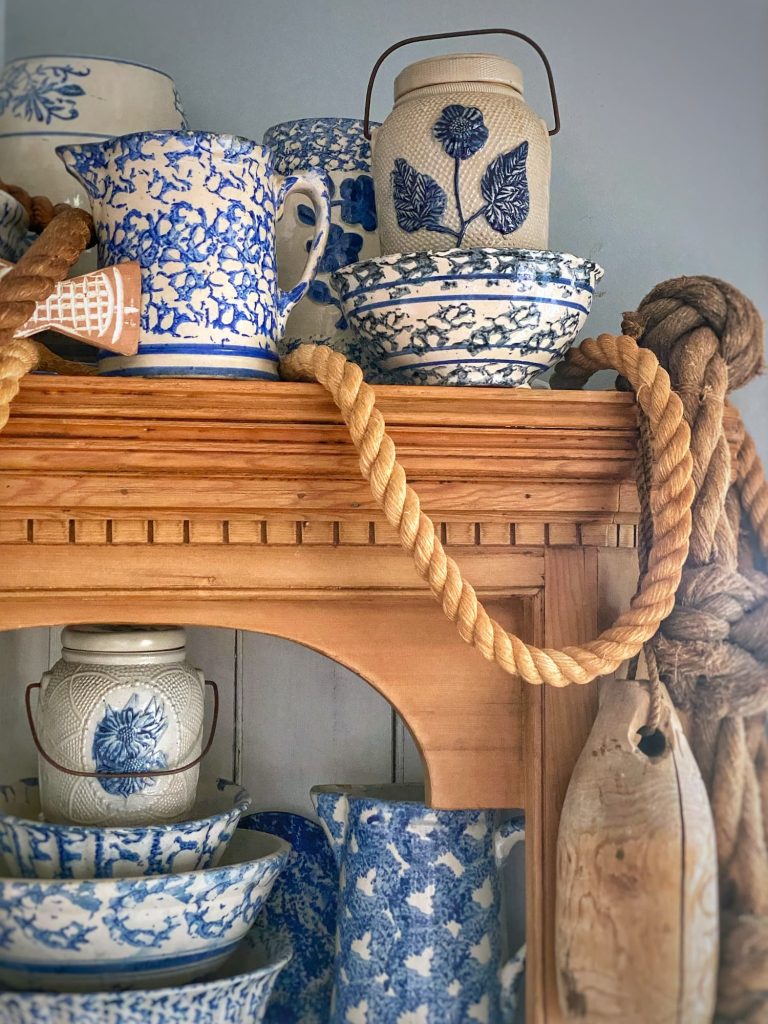
China, pottery, stoneware, earthenware, ironstone, porcelain. I love it all!
But what’s what?! And how do they differ?
I have to admit that I get confused.
Let me try to clear it up a bit — for both you and me!
And while I am at it, I will explain the difference between antique and vintage too. That one is easy!
Earthenware, Stoneware, or Porcelain?
Pottery and ceramic are basically the same thing. They are both items made of clay, hardened by firing, and then decorated or glazed.
Pottery, though, has come to refer more to vessels that hold things such as mugs, pitchers, bowls, and crocks.
That is why I used both “pottery” and “dishes” in my blog title.
There are three different kinds of pottery/ceramic, which are differentiated by the type of clay that is used and the firing temperature.
Earthenware is made from clay fired at relatively low temperatures. It is porous and must be glazed to be used for functional purposes. It has a rustic look and chips easily.
Stoneware is made from a particular type of clay and is fired at a higher temperature, resulting in a harder, denser, and more durable product.
Porcelain comes from a refined clay called kaolin. It is fired at very high temperatures, creating a hard, shiny material often white and translucent in appearance. Porcelain originated in China, which is why it is often referred to as “fine china”.
Sometimes ground animal bone is mixed into porcelain clay for increased durability. This is called bone china.
Everyone’s favorite, ironstone, is technically earthenware, but the addition of iron slag or flint, makes it more durable and similar to a high-quality stoneware. With it’s traditional white glaze, it has the look of fine porcelain at a more affordable price.
This is how I understand it all.
Clear as mud? (Or clay?!)
Antique or Vintage?
According to Martha — and most all collectors, historians, and experts — antiques are objects that are over 100 years old.
Vintage items are over 20 and less than 100.
And apparently, true vintage refers to items between 50 and 100 years old. That one is new to me!
Collecting
Within the categories of earthenware, stoneware, and porcelain, there are different types of pottery and dishes, based on their style, glaze, and decoration.
Of course I have some favorites!
Blue and white transferware
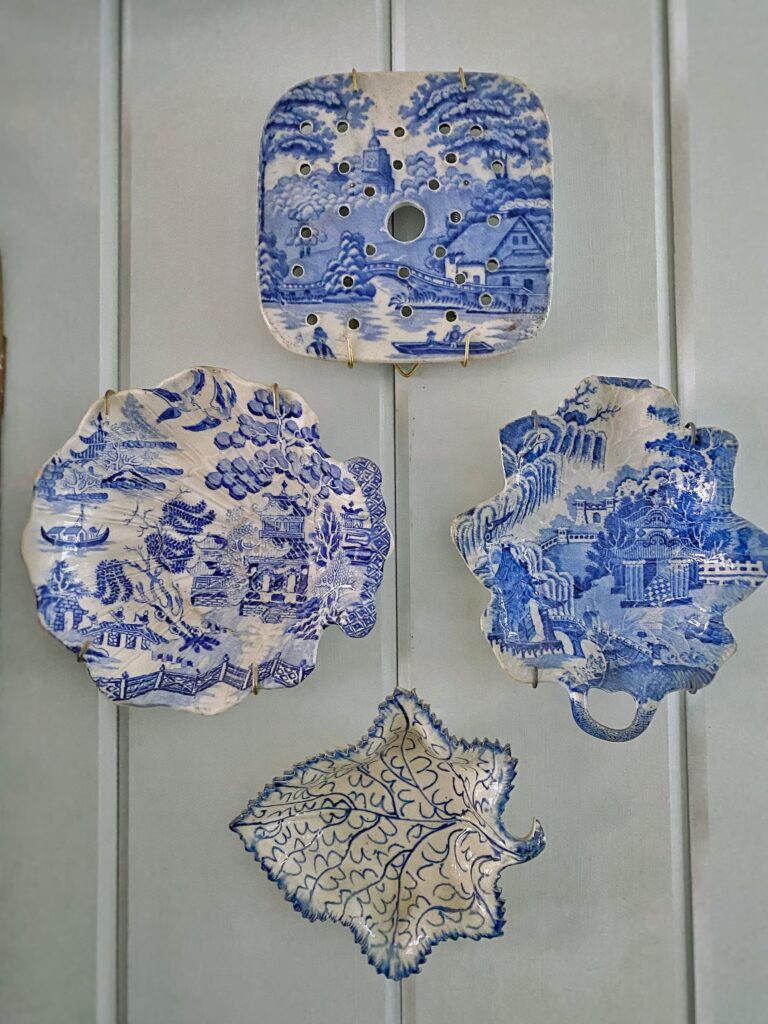
I started my antique dish collection with the blue and white transferware I inherited from my mom.
My parents lived in London during the early 1980’s, and my mom was a regular at the local antiques stores and markets. During that time, she learned all there was to know about antique transferware dishes and amassed an impressive collection.
Transferware is primarily earthenware, but it can also be found on ironstone and porcelain.
This style of dishes gets its name from the technique used to create each piece’s intricate design.
In the 1750’s, artisans in England began to etch designs on copper plates and then use very thin paper to transfer them to pottery pieces. Previously the design on each piece had to be hand-painted, so this was a way to “mass produce” decorative dishes.
Each pattern had a name. The most well-known is the iconic Blue Willow chinoiserie pattern. My mother certainly collected plenty of those, but she particularly loved pieces with more unusual patterns — exotic locales, bucolic scenes, animals, florals, and English country homes.
Most of my mother’s pieces date to the early 1800’s.
They are true treasures, and I am grateful to live with this daily remembrance of my mom in my home.
Cornishware

With its cheery blue and white stripes, Cornishware was love at first sight for me.
I have picked up a few pieces from local antiques stores and received some as gifts, but I bought most of my collection in one fell swoop from someone who was getting rid of hers.
Lucky me!
Cornishware is made from special Cornish clay. Don’t ask me what that makes it… Maybe stoneware?? Clear as clay, right?
Cornishware was first produced in 1920, so I guess that means the very early pieces would be antiques. My collection, however, consists of vintage and some newer pieces.
I choose pieces that appeal to my eye, going for a mix of shapes and sizes.
I wrote an entire blog post on my cornishware collection.
Link here to read more on Cornishware history and how I display it in my home!
Spongeware
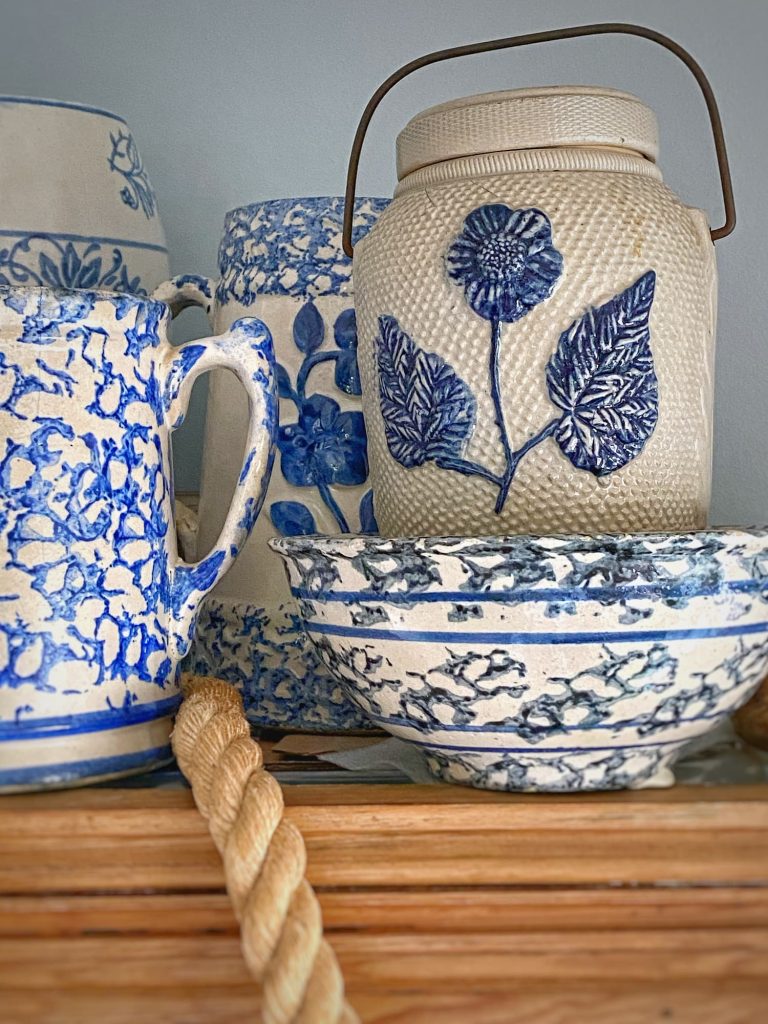
I fell in love with antique spongeware when I saw it on Instagram in the beautiful home of fellow Maine-resident Loi from @loithai.
These utilitarian stoneware pieces, most commonly bowls and pitchers, were, as the name indicates, decorated using a sponge-like tool.
Mine are antiques, each with their own unique pattern and quirks. I love their folk-art charm!
Vintage McCoy sponge or spatterware pieces from the mid-20th century tend to have a curvier and more refined style.
I was lucky to acquire most of my collection in two batches from local auctions.
Fish Plates
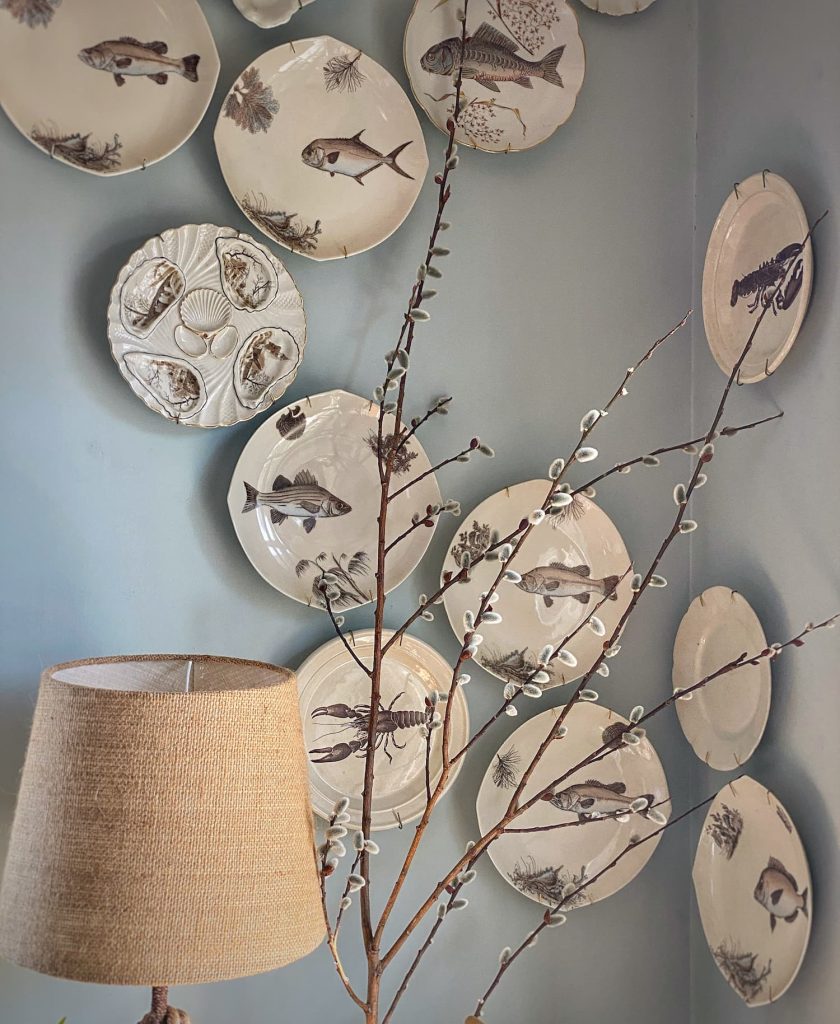
I found the vintage hand-painted Limoges porcelain fish plates I have hanging in the dining area at a local antiques store.
You can find similar sets from France, Austria, and Germany on sites such as Etsty, eBay, and 1st Dibs. Or if you are lucky at a local antiques store!
These were commonly made in large sets, which included plates, a large platter, and sauce dish. They make quite the presentation!
Crocks
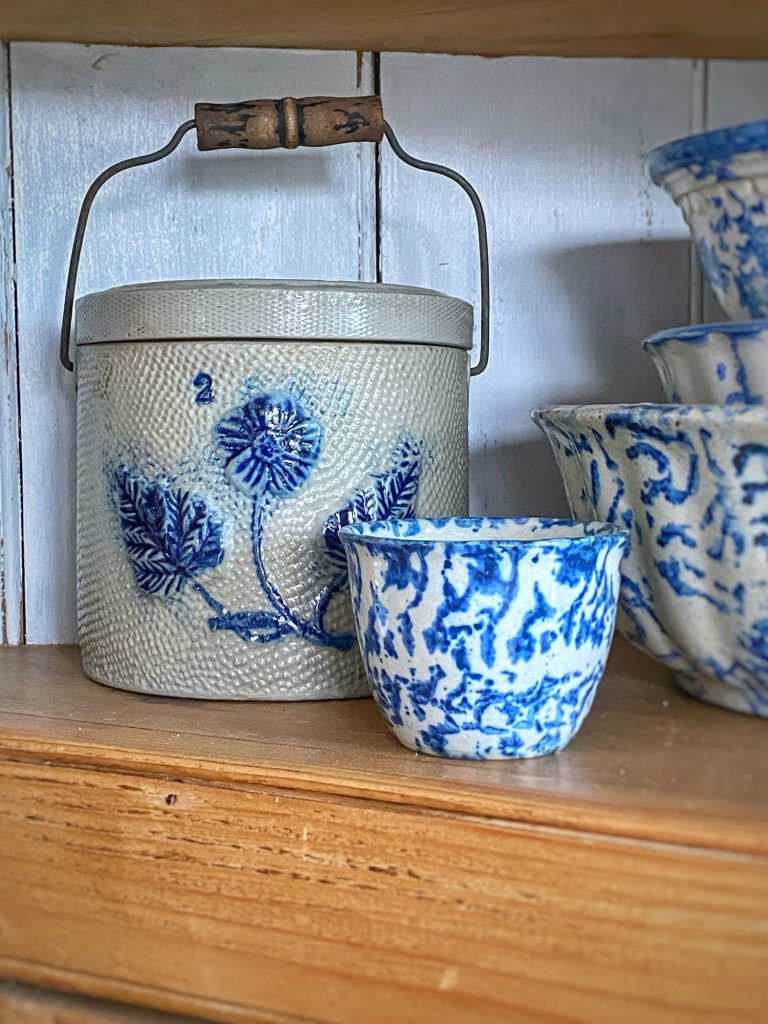
I am not a big collector of antique or vintage crocks, but I fell hard for three small Whites of Utica stoneware crocks at Brimfield this past week.
Their diminutive size, textured salt glaze “orange peel” finish, and raised blue floral decorations definitely checked all the boxes for me!
I knew they would look great mixed in with my spongeware.
Since this is a new collection for me, I have to admit I don’t know much about them.
I did a little poking around online and it seems these pieces probably date to the late 1800’s or maybe early 1900’s.
Whites also made pitchers/jugs in a similar design.
At this point I don’t know if this is a collection I will continue to grow. I am certainly smitten, but I definitely had to squeeze them in. So space constraints might dictate I limit my collection to just these.
Three, afterall , constitutes a collection!
Display
The best part about a collection is enjoying it on display in your home!
Here are the ways I display my dishes and pottery.
Hutch displays
I have two scrubbed pine hutches in the dining area — one large, and the second a small corner hutch.
Oh, “What is a hutch?” you ask.
A hutch is a piece of furniture with open shelves on the top and a base of drawers and cabinets. It is typically used in the kitchen or dining area to hold dishes, glassware, and other dining essentials.
In my opinion, the best part about a hutch is that there is plenty of room to display your dish and pottery collections!
Several years ago, I painted the backs of the shelves on both my hutches white. I do like the look of the natural wood, but the white really brightens things up and makes my collections pop.
I have also done a peel-and-stick wallpaper on the back of the big hutch. That was fun! And it was easy to remove when I wanted something different.
Note: If you are going to use peel-and-stick wallpaper, check first to make sure it doesn’t pull the finish off when you remove it.
When it comes to hutch displays, I generally like to pile it on. I am going for a casual unstyled look.
A more formal completely symmetrical arrangement is also lovely.
And just a few special pieces set on the shelves can be both striking and calming.
The big hutch
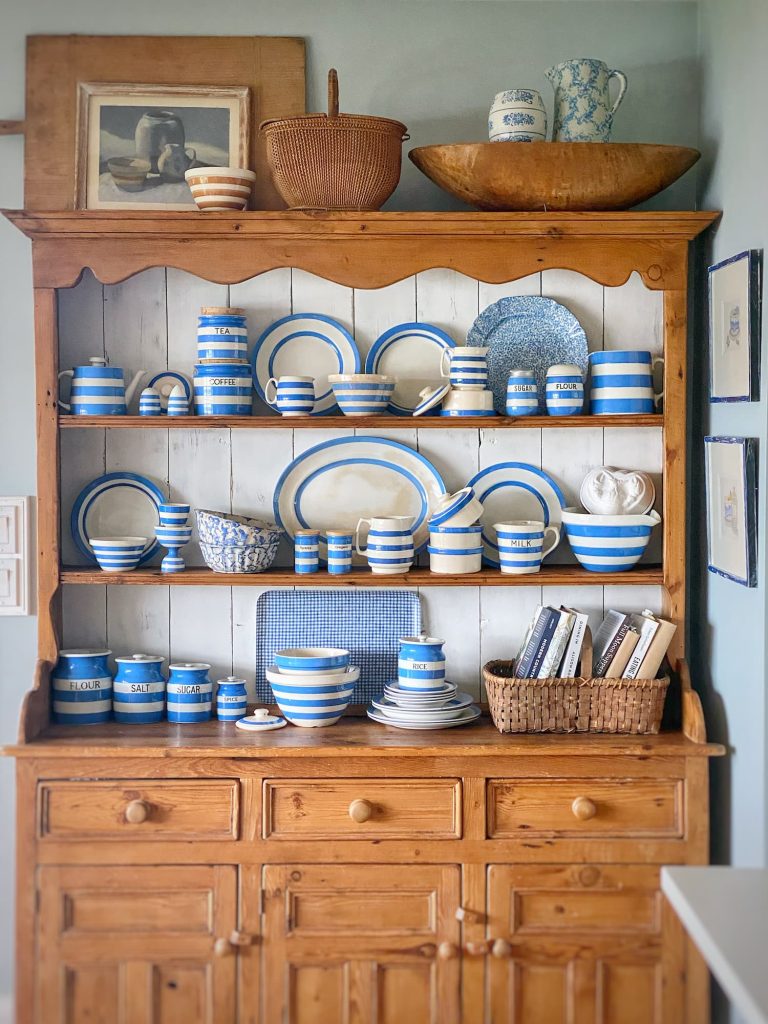
This year I made a few changes to my summer cornishware display in the big hutch.
The arrangement is seemingly random, but I still achieved balance by taking size, shape, and height into consideration when placing each item.
I also included a few pieces of spongeware to tie the two hutches to each other.
And on the top, I placed a pitcher, crock, and bowl to mirror the small painting on the far left.
The corner hutch
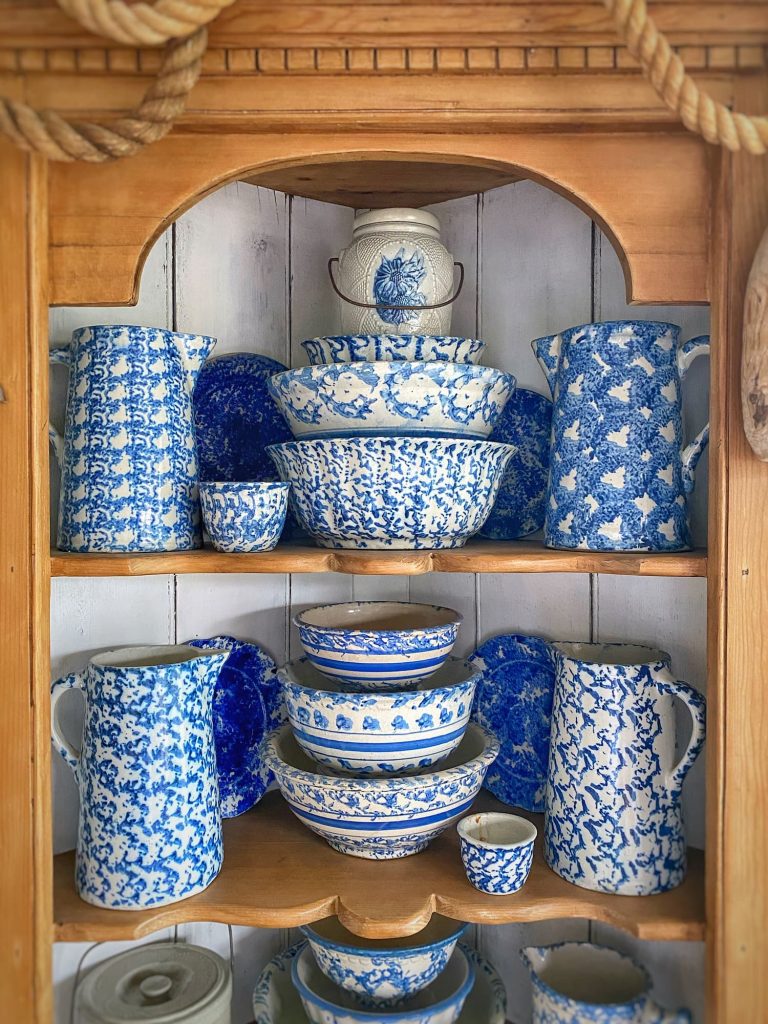
The display of spongeware in the corner hutch is basically symmetrical, with a few items that throw it a bit “off” and keep things interesting– the small bowls alternating sides on each shelf, and the addition of my new Whites Utica crocks on the bottom left and top shelf center.
And the top of the hutch is a jumble of pottery and rope, with a few nautical touches thrown in for good measure.
As always, I encourage you to play with your designs and have fun!
Wall display
A plate wall is a classic design element.
School of fish
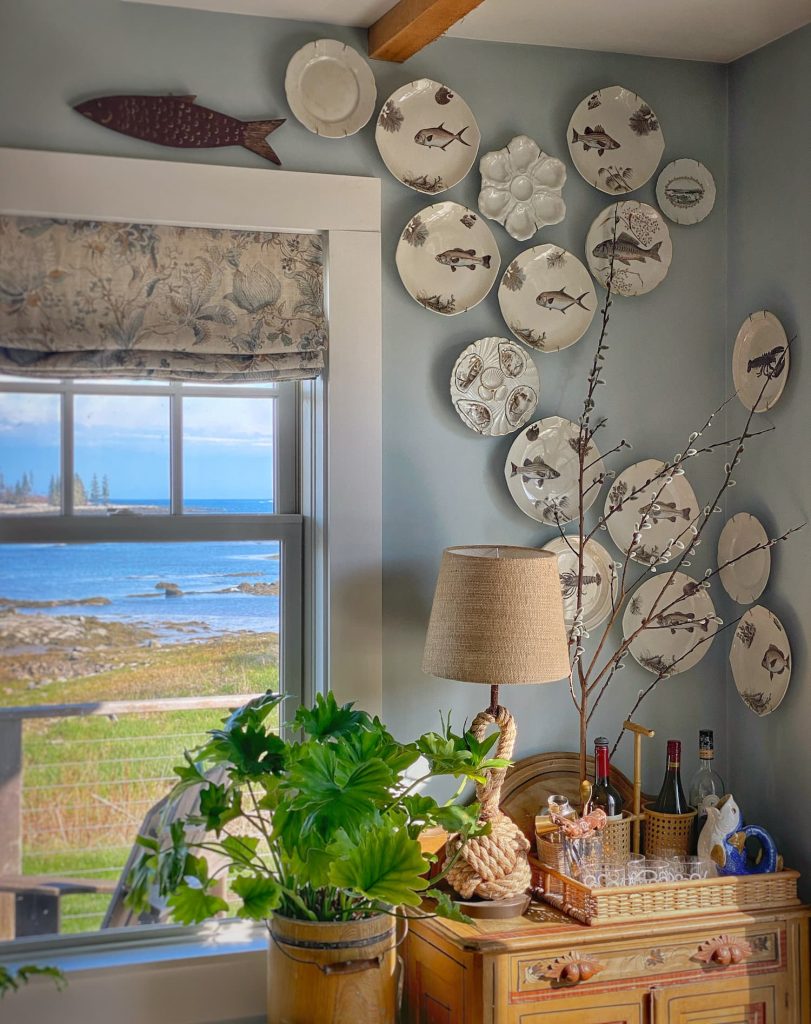
In the dining area, I have my collection of porcelain fish plates displayed in an asymmetrical pattern that flows from one wall to the next, then up and over the window.
To fill out the display and add interest, I included some plates that are “not like the others” — oyster plates, plain white ironstone, and recently two ironstone lobster plates. Leading the whole “school” at the top left is a wood carved fish,
The entire grouping is united by a single color palate.
Fireplace blue and white
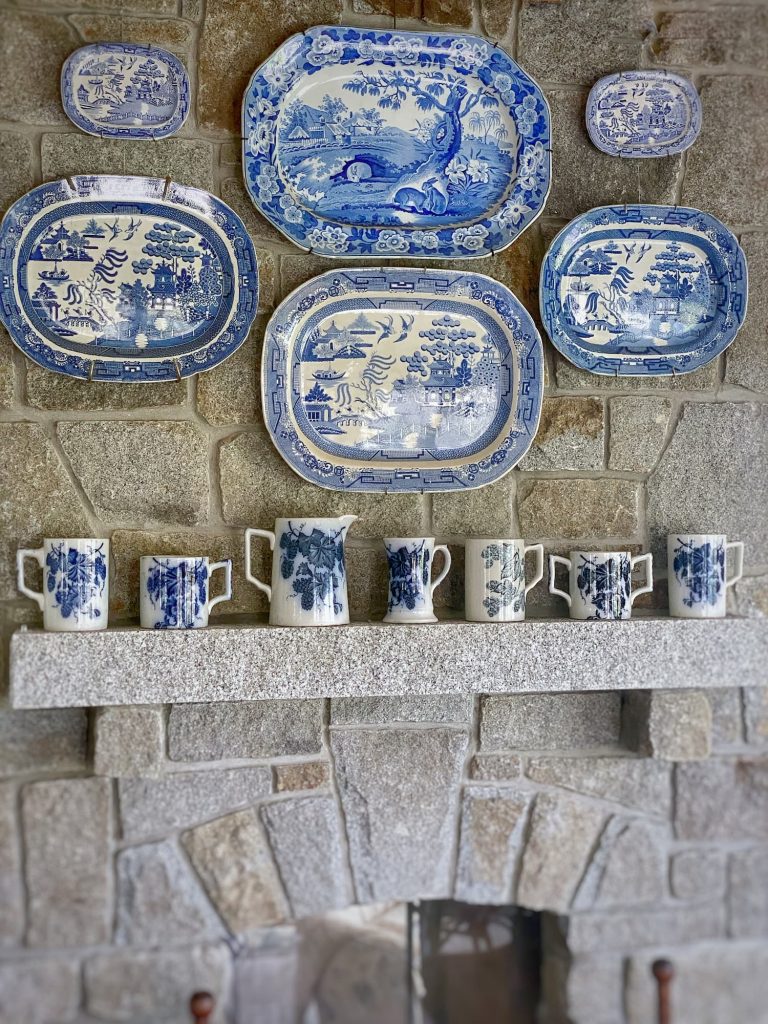
Above the mantel in the dining area, I have a completely symmetrical arrangement of blue and white transferware platters.
Yes, I can do symmetrical!
With this arrangement, the interest comes from the contrast of the smooth refined earthenware with the rough organic stone.
I get a lot of questions about how I hung the platters on the stone. Similar to Victorian picture moulding, the platters hang from wires that are attached to hooks with long “tails” that slide in between the top of the stone and the ceiling. I fashioned the hooks from sturdy wire clothes hangers.
Hall blue and white
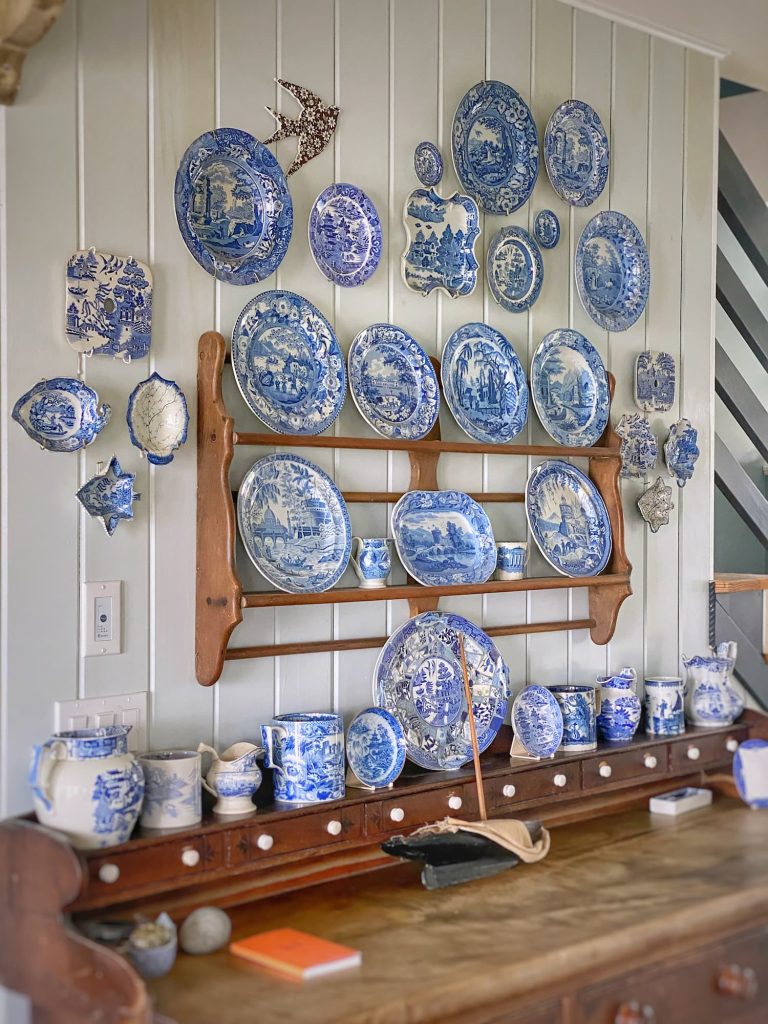
In the front wall above the big sideboard, I have a large wall display of more blue and white transferware.
The plates are displayed on both a plate rack and hung on the wall.
The arrangement is mostly symmetrical, but I couldn’t resist adding a swoop upwards on the right.
I also included a bird made from a brown and white plate just for fun!
You can read more about plate walls in my blog post Creative Wall Decor Part 2: Non-Art Displays
Flat surface display
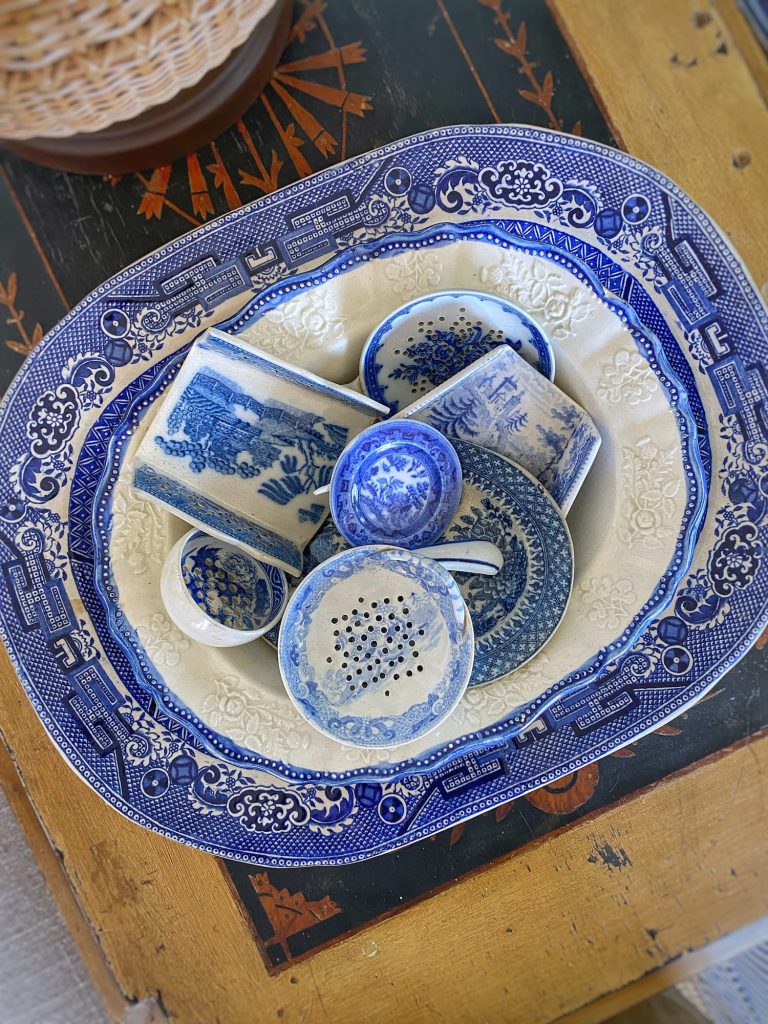
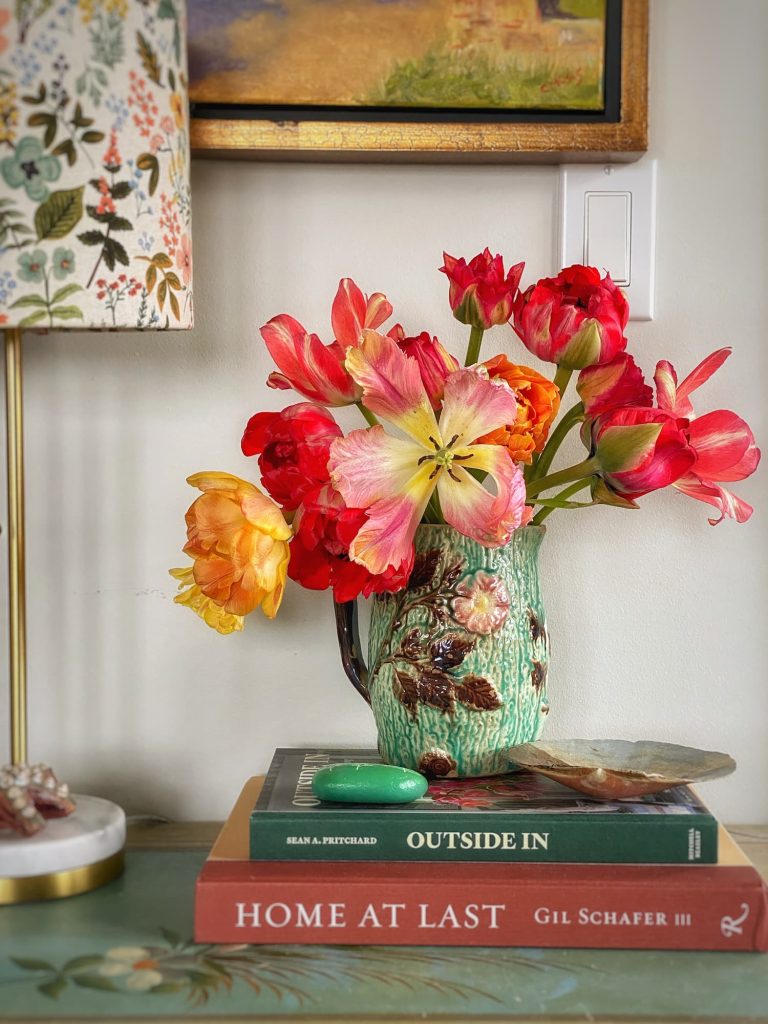
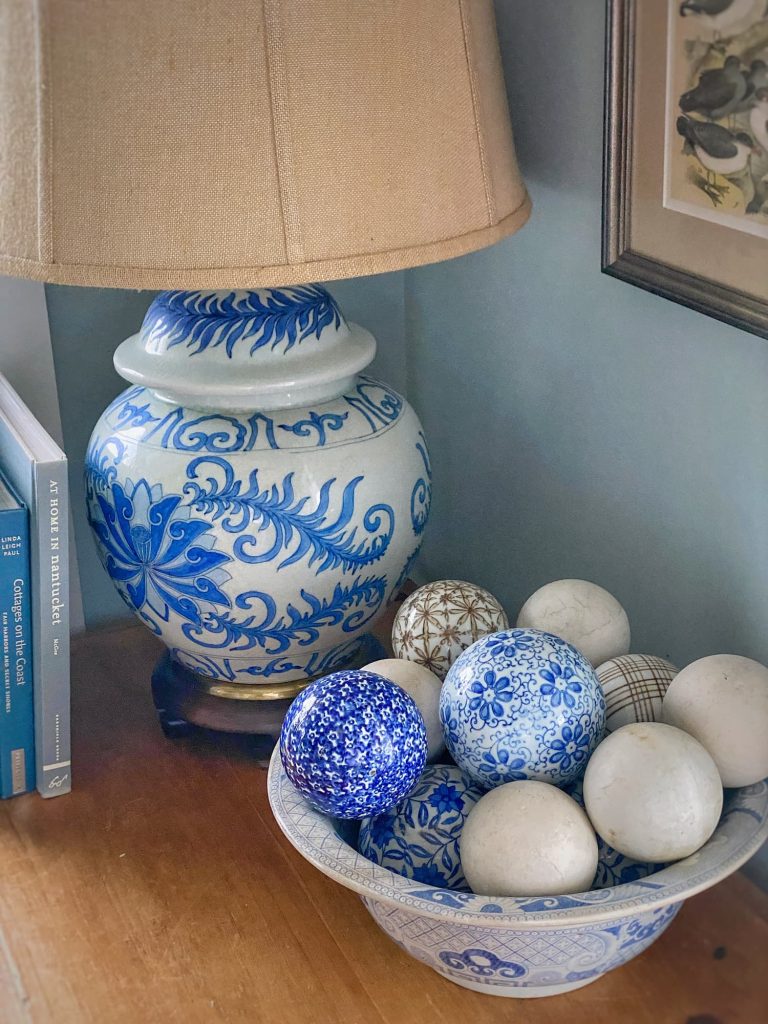
Don’t ignore flat surfaces, such as mantels and tabletops when displaying your pottery and dishes!
I have blue and white pitchers, jugs, and mugs lined up on both the dining room mantel and also the small ledge that runs along the top of the hallway sideboard.
You can also display plates on shelves and other flat surfaces using a plate stand. These range from unobtrusive plastic to simple wood, to ornate metal that is decorative in its own right.
Fill a pottery bowl with porcelain balls, glass fish floats, pinecones, fresh fruit, Christmas ornaments, napkins, or it can just be a beautiful catchall. A blue and white bowl on my kitchen island at the moment holds a phone charger, spare reading glasses, a lightbulb, an electronic lighter, and package of seeds.
I love to use my large platters decoratively like a tray. Place one on the coffee table with a candle and small vase of flowers or a plant.
Or you could just display a stack of different-sized platters all on its own.
And of course an antique pottery pitcher is perfect for holding fresh flowers.
Can I say it again? Get creative!
This Week Into Next
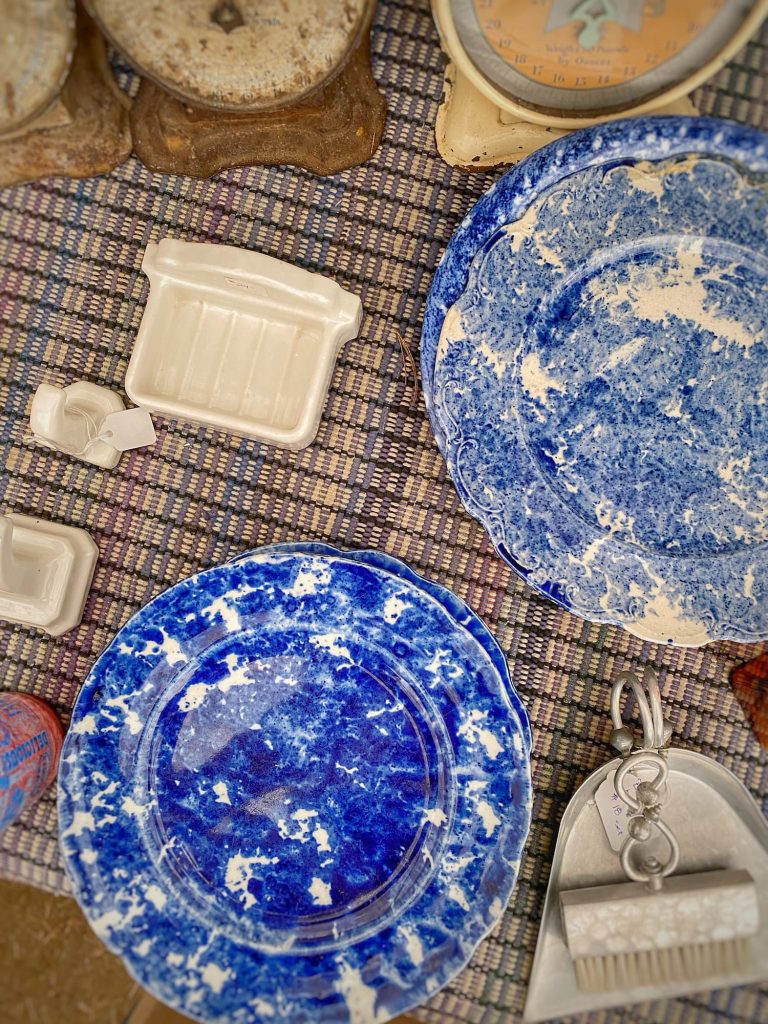
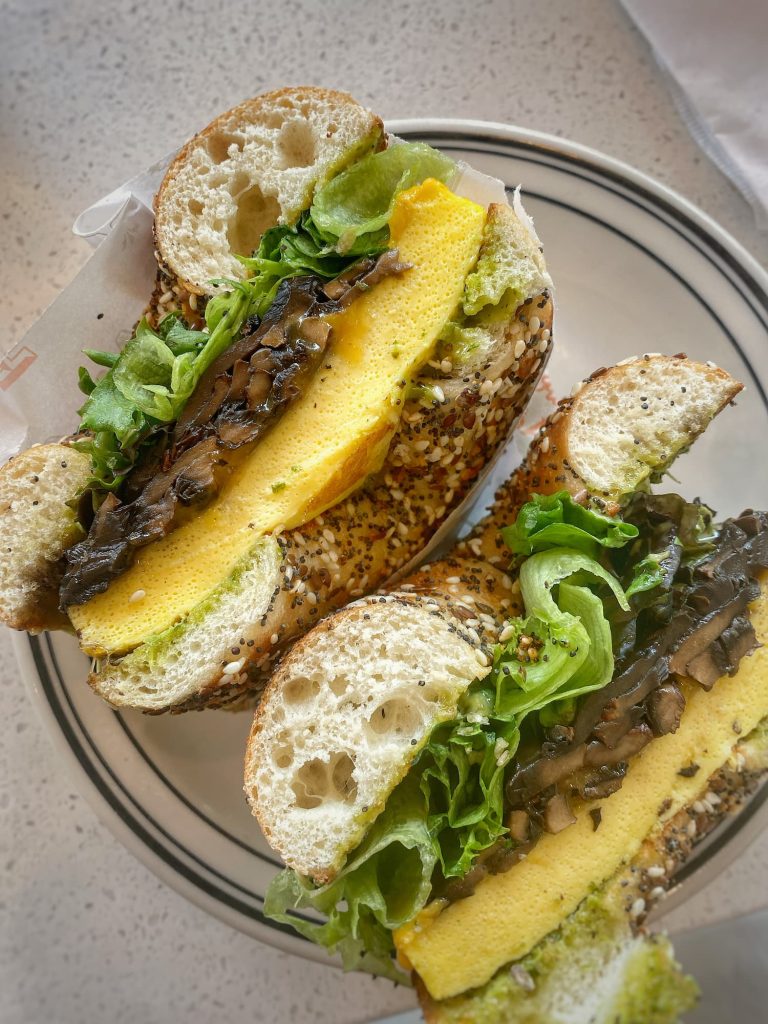
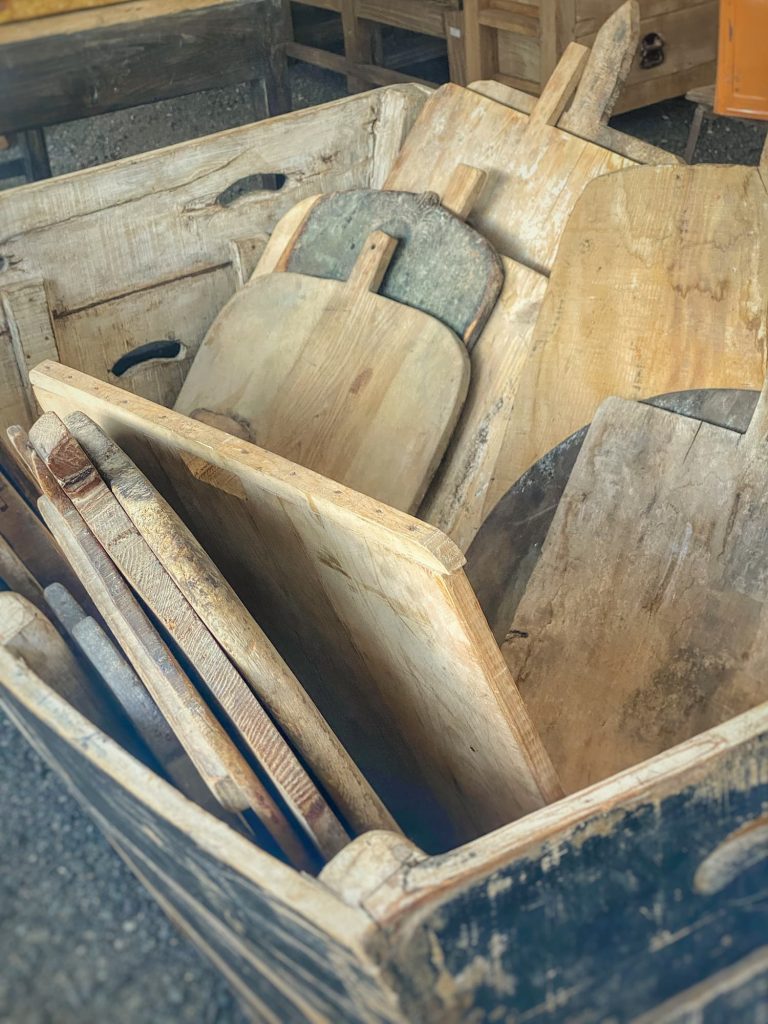
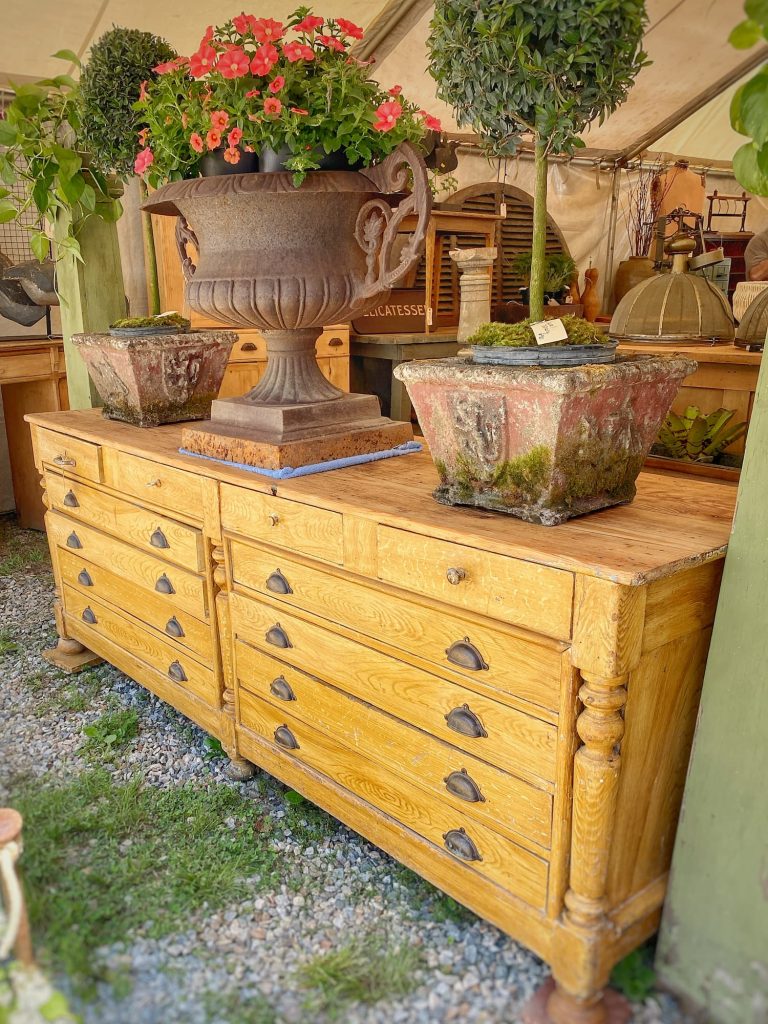
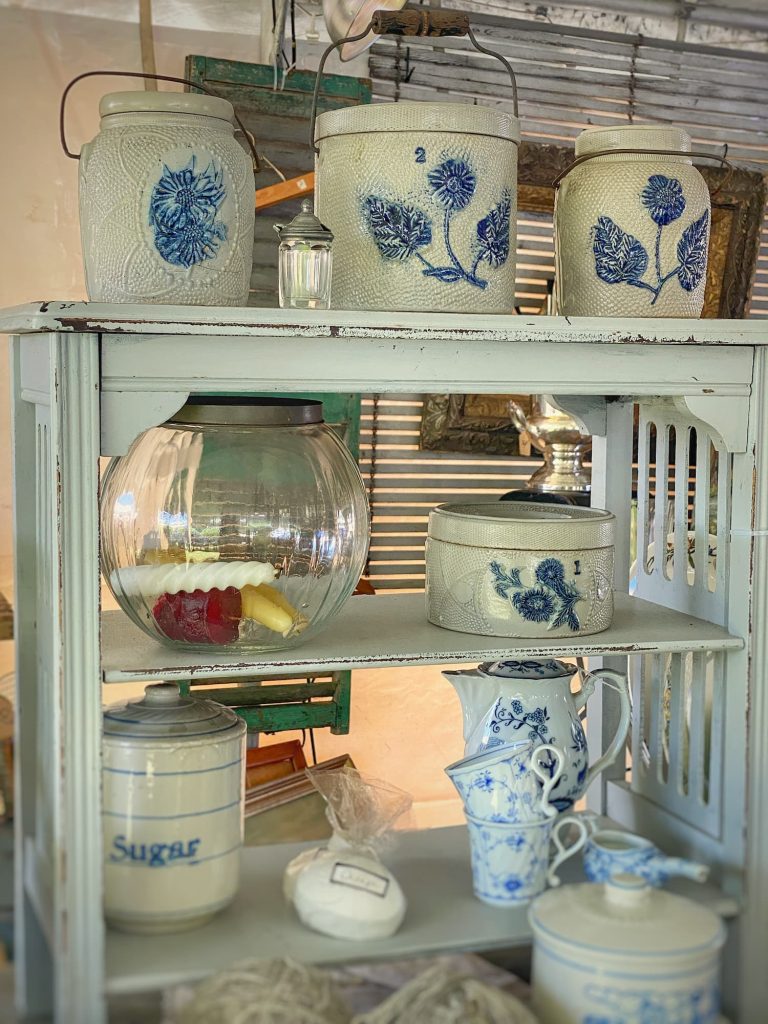
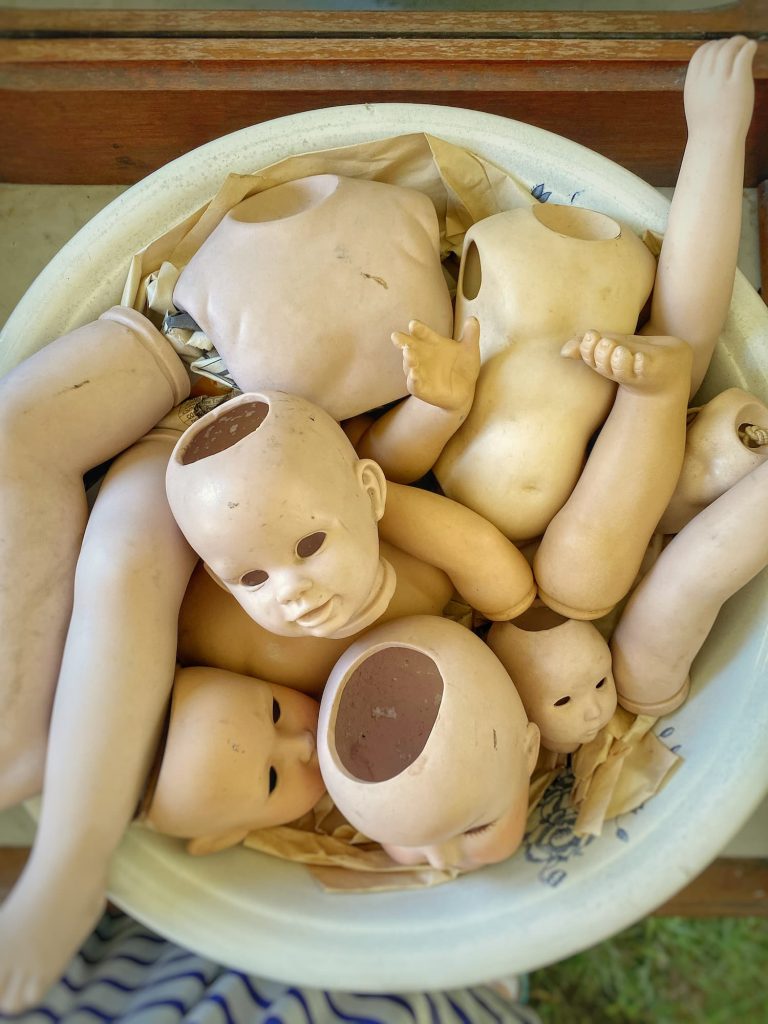
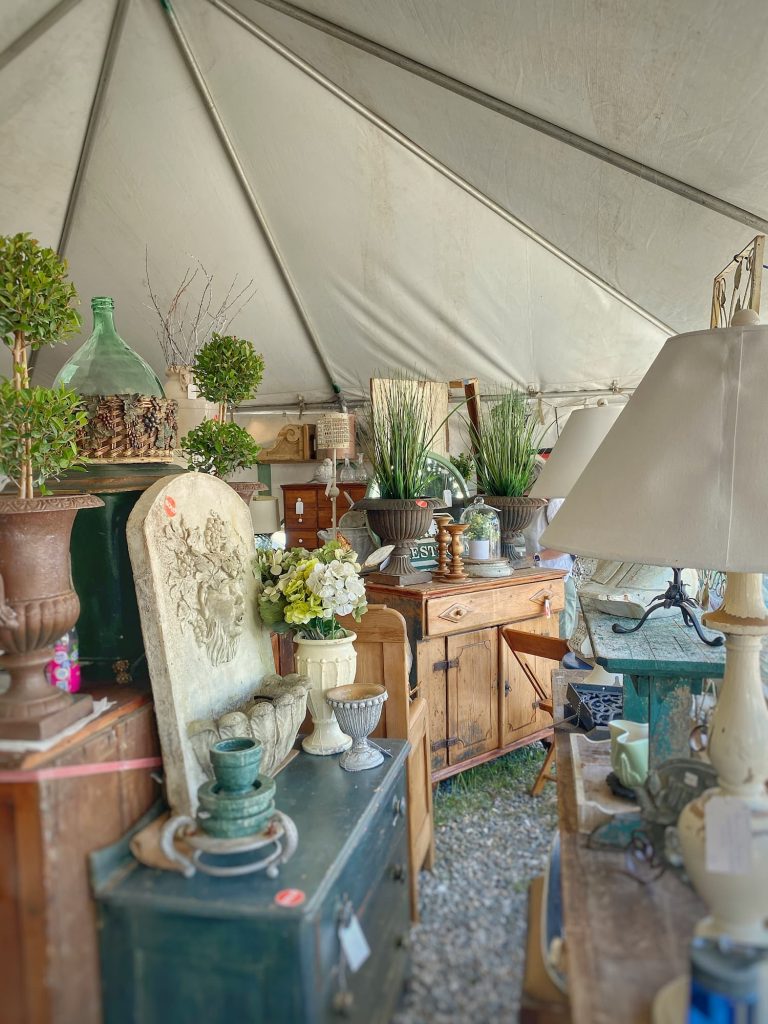
Gosh, my posts always end up longer than I plan. Sorry! I just get going on a subject and find I have so much to say!
If you made it this far, thank you for sticking with me!
I am finishing up this blog post late on Friday, since I was gone earlier in the week. So even I am feeling the need to wrap things up now!
I did have a fabulous trip to visit my friend in Brookline. We had two wonderful dinners out. Plus my favorite — a bagel and egg sandwich — for breakfast before I headed back to Maine.
The weather was sunny and warm. Trees had leafed out. Some were covered in pink blossoms. It was lovely. Sigh.
And while we only spent about a half a day at Brimfield, it was enough.
Unfortunately, two of my favorite fields from last year were not yet open. But it was fun to be there on the first day for those that were. It was surprising how some of the booths already had many “sold” tags on their furniture pieces. Wow, were there some beauties! Furniture I do NOT need, though…
And as you know, I did not come home empty-handed.
Spring also made some progress here in Maine while I was gone!
I think this weekend I will try to get my annuals planted.
With Memorial weekend looming, it is time to get ready for summer — yard tidied, deck readied — even though it is just barely spring here!
In Zoe’s Kitchen
This week Zoë will be sharing what she eats when she doesn’t feel like cooking. Sounds like a helpful one for all of us!
If you missed it, last week here on the blog I shared my rarely seen “snug”!
I really am done now! Phew!
Be well, friends!


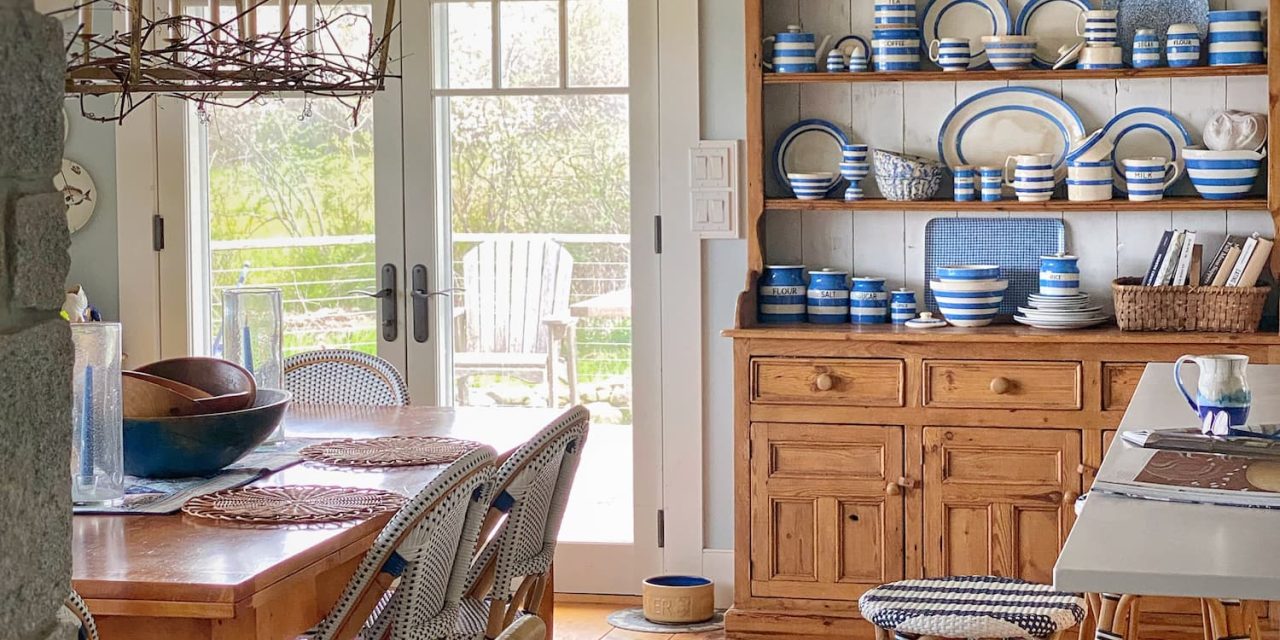





Share your 3 newest crocks, please.
Enjoyed your pieces and what you shared.
Thank you.
Hi Nan! I shared them in photos! Thanks for reading!
Molly, your home is beautiful, and feels so comfortable! I really look forward to your posts. My husband and I are moving from the city to our lake house, and I hope I can make it feel as welcoming as yours. What is the paint color that is in your dining room and kitchen.? It looks like a soft blue green from the photos, and I would love to duplicate it. Thank you!
Hi Kathy! Thank you! It is definitely a comfortable home! Decorate your new place with things you love and it will surely feel welcoming! The paint color is Benjamin Moore Brittany Blue. It is a gray blue with some faint green undertones. A great color!
Brimfield score! I love the crocks you found. Never seen anything like them and they are a great addition to your already beautiful collection.
And I thank you for the tutorial on the composition and history of all things crockery/dishes/objects. Always nice to learn something about the things we find beautiful and useful in our homes.
Thank you, Karen! I had never seen anything like them either. Surprising, for all the antiquing I have done. Or maybe I just never noticed them before. My eyes immediately fell on these when I entered the booth, though! And yes, I have never really understood the difference between the different kinds of pottery, so I really need to clear things up!
Dear Molly, love the week-end and I can enjoy your wonderful post. Like your Mom when we lived and worked in London, I would take the train to Stoke on Trent and visit the potteries. So many good memories of blue and white dishes, Christmas plates for less than $1.00 and lovely old furniture I would say you could buy by the pound. Always keep good memories with you.
Hi Mary Ann! I am so happy you enjoy my blog! Thank you for reading it! My mom used to go to the factory stores and also amassed a huge collection of Spode Christmas dishes — all seconds. And have you seen her collection of Spode Queen’s Bird dishes that I have? They were our “good dishes” when I was growing up. It includes so many different size plates and bowls. Even a tea and coffee set! All seconds! I shared them in my post I Am My Mother’s Daughter.
Molly, this is so interring and helpful. Thank you. I’ve always wondered the difference between pottery, ceramics, stoneware, ironstone, etc. And I still probably don’t have it straight but now I have a reference. Even more than your collections I admire your talent for display. Your house is a masterclass in creativity and I love seeing how you incorporate new pieces and adding seasonal flare. Happy weekend! xo
Oh, thank you, Juliet! I love arranging things! I sometimes think I should have done window and shop displays as a career. I have so much fun creating displays! I am not sure I have the whole pottery thing straight yet, but I at least have a better understanding!
Molly, I love seeing your collection. Everything is so beautifully displayed. I love Transferware blue and brown are my favorite.
Have a wonderful weekend, enjoy the spring weather.
Thank you, Elizabeth! I love creating displays around the house with everyday objects. I have a few pieces of brown transferware too. Have a great week!
Molly this was such a great post! I learned so much about pottery and plates. I adore how you have displayed your treasures. You have an eye and I love that you add in mismatched gems that pop. The whole thing really looks so cool, especially when you go asymmetrical. I bet your mother would love that you have her treasures. She has some really cool plates.
I so want to get to Cornwall someday and buy a few blue pieces. My favorite pottery I own are from a shop in Positano and I put it out in summertime on my kitchen shelves.
Hope you have a lovely weekend in Maine! I am going to share this on my weekend blog! xo
Thank you for sharing my post in your blog on Saturday! I do have fun with my arrangements — creating an organic display or adding in something that is “not like the others”. I will have to look closely at your photos to see your dishes from Positano! Have a great week!
You have a wonderful collection of pottery! I’ve always loved blue and white pottery and porcelain. That booth at Brimfield had me drooling! Enjoy your summer!
Hi Carla! I also have just a bit of a thing for blue and white pottery, ha! And yes, there were some beautiful items in the booth where I got my crocks!